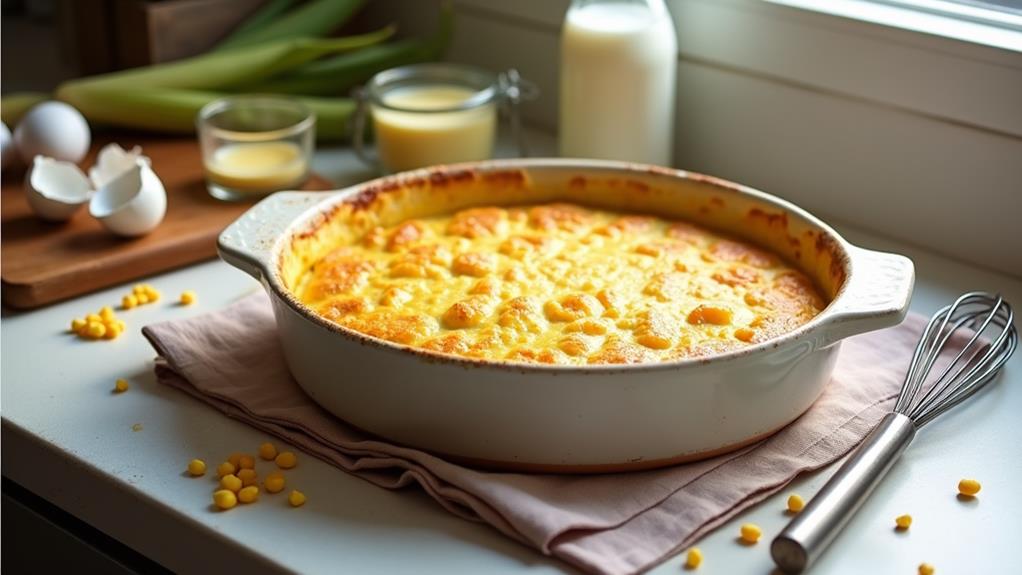Did you know that nearly 30% of all corn grown in the U.S. is used for food products, including the beloved corn pudding? This dish, with its rich history and varied interpretations, often evokes nostalgia and brings people together during special occasions. You might find it interesting how traditional recipes have evolved over time, adapting to modern tastes and dietary preferences. Yet, what truly sets corn pudding apart from other sides is its unique blend of textures and flavors, inviting you to explore its many facets further.
History
Corn pudding has roots that trace back to Native American cuisine, where corn was a staple ingredient. It's fascinating to think about how this humble grain has shaped our culinary traditions.
The corn origins in North America are rich, with Indigenous peoples using it not just for sustenance but also for cultural practices. They recognized corn's importance long before it became the beloved ingredient that's recognized today.
As you explore the history of corn pudding, you'll see its cultural significance extend beyond just food. It represents community and sharing, often served during gatherings and celebrations.
When you prepare corn pudding, you're not just cooking; you're honoring a tradition that connects you to those who've come before you. Imagine the warmth of family and friends coming together, sharing stories and laughter, all while enjoying this comforting dish.
Recipe

Corn pudding is a delightful and comforting dish that has its roots in Southern cuisine. This creamy, custard-like side dish combines the sweetness of corn with a rich, smooth texture, making it a perfect accompaniment to any meal. Corn pudding can be served warm or at room temperature, and its subtle flavors are sure to please a crowd during family gatherings or holiday celebrations.
To prepare corn pudding, you'll need to gather a few simple ingredients that create a harmonious blend of flavors. The base of the dish is made from fresh corn, which can be either canned, frozen, or fresh off the cob. The addition of eggs and milk creates a rich custard, while sugar provides a touch of sweetness. Baking the pudding results in a deliciously tender texture that's both comforting and satisfying.
Ingredients:
- 2 cups fresh or frozen corn kernels
- 1 cup milk
- 3 large eggs
- 1/4 cup granulated sugar
- 1/4 cup all-purpose flour
- 1 teaspoon baking powder
- 1/2 teaspoon salt
- 1/4 cup unsalted butter, melted
- 1 teaspoon vanilla extract (optional)
To prepare the corn pudding, preheat your oven to 350°F (175°C). In a large mixing bowl, combine the corn, milk, eggs, sugar, flour, baking powder, salt, melted butter, and vanilla extract. Whisk the mixture until all the ingredients are well combined and smooth.
Pour the mixture into a greased baking dish and bake for 45-55 minutes or until the top is golden brown and a toothpick inserted in the center comes out clean. Allow the corn pudding to cool slightly before serving.
When making corn pudding, feel free to adjust the sweetness to your taste; you can add more sugar if you prefer a sweeter dish or reduce it for a more savory flavor. Additionally, you can experiment with different types of corn, such as using a combination of sweet corn and creamed corn for extra richness.
For a twist, consider adding ingredients like cheese, jalapeños, or bacon for a savory variation.
Similar dishes include corn casserole, which often incorporates cheese and a cornbread mix, and spoon bread, a softer, cornbread-like dish with a custard consistency. Each variation brings its own unique flavors while still honoring the comforting essence of corn pudding.
Final Notes
When serving corn pudding, consider how it complements a variety of dishes, from roasted meats to holiday feasts.
It's a versatile side that brings warmth and comfort to any table, making it perfect for gatherings with family and friends. You might want to try serving it alongside grilled chicken, baked ham, or even a hearty vegetable stew for a delightful contrast of flavors.
When it comes to ingredient variations, don't hesitate to get creative! You can add cheese for a rich, creamy texture, or toss in some jalapeños for a spicy kick.
Herbs like thyme or chives can elevate the dish, adding freshness and depth.
For serving suggestions, think about portion sizes. A small scoop is great for casual dinners, while a larger serving might be more fitting for festive occasions.
You could even serve it in individual ramekins for a charming touch!

